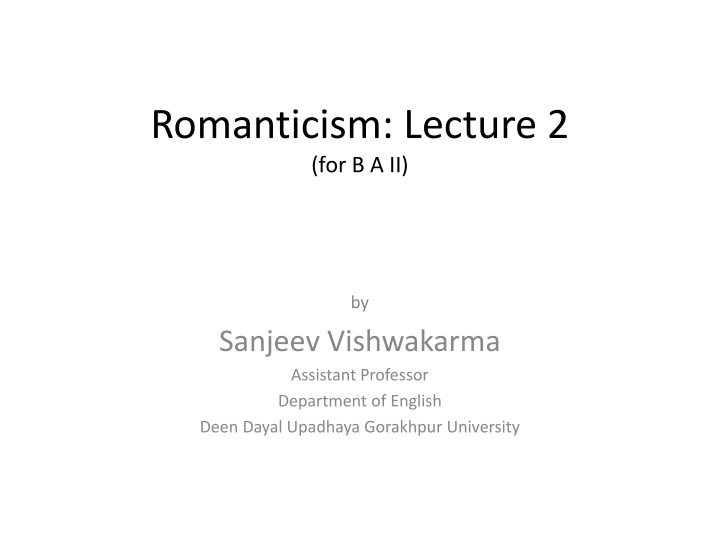
Exploring Romanticism: Insights from Lecture 2 by Sanjeev Vishwakarma
Dive into the world of Romanticism through Lecture 2 by Sanjeev Vishwakarma, Assistant Professor at Deen Dayal Upadhaya Gorakhpur University. Discover the essence of Romanticism, its schools, key traits, and definitions provided by experts like Rene Wellek and Michael Ferber.
Download Presentation

Please find below an Image/Link to download the presentation.
The content on the website is provided AS IS for your information and personal use only. It may not be sold, licensed, or shared on other websites without obtaining consent from the author. If you encounter any issues during the download, it is possible that the publisher has removed the file from their server.
You are allowed to download the files provided on this website for personal or commercial use, subject to the condition that they are used lawfully. All files are the property of their respective owners.
The content on the website is provided AS IS for your information and personal use only. It may not be sold, licensed, or shared on other websites without obtaining consent from the author.
E N D
Presentation Transcript
Romanticism: Lecture 2 (for B A II) by Sanjeev Vishwakarma Assistant Professor Department of English Deen Dayal Upadhaya Gorakhpur University
Acknowledgement This presentation has been prepared after consulting various books on the Romanticism. It extensively quotes from the book Romanticism: A Very Short Introduction the explanation of the contents is the teacher s own (based on his readings about the age). The teacher doesn t claim any authority over the contents included in this presentation. This presentation is meant only for giving a basic understanding of the age by exploring some facts and concepts in the above mentioned books. It has not been produced for any commercial purposes.
Suggested Readings Ferber, Michael. Romanticism: A Very Short Introduction. New York: OUP, 2010. Ferber, Michael (ed). A Companion to European Romanticism. UK: Blackwell Publishing, 2005. Day Adian. Romanticism: The New Critical Idiom. New York: Routledge, 1996. James, R A Scott. The Making of English Literature. UK: Martin Secker and Warburg LTD, 1940.
Romanticism Schools of Romanticism: A O Lovejoy investigated three literary schools or movements, one English, one German, and one French, to which the term habitually had been applied, and he could find no common characteristics among them (quoted in Romanticism: A Very Short Introduction, 1). It was very plainly set forth that romanticism was nothing more than the union of gay and the serious, the grotesque and the terrible, buffoonery and the horrible; in other words, if you prefer, of comedy and tragedy (quoted in Romanticism: A Very Short Introduction, 2).
Romanticism Rene Wellek proposed three traits or norms shared by those authors whom we call Romantic: imagination for the view of poetry, nature for the view of the world, and symbols and myths for poetic style (Romanticism: A Very Short Introduction, 9). Harold Bloom has claimed that Romanticism is the internalization of quest romance , a transformation of the heroic quests in medieval romances into interior spiritual journeys (Romanticism: A Very Short Introduction, 10).
Romanticism Michael Ferber tries to define Romanticism is the following words: Romanticism was a European cultural movement, or set of kindred movements, which fond in a symbolic and internalized romance plot a vehicle for exploring one s self and its relationship to others and to nature, which privileged the imagination as a faculty higher and more inclusive than reason, which sought solace in our reconciliation with the natural world, which detranscendentalized
Romanticism religion by taking God or the divine as inherent in nature or in the soul and replaced theological doctrine with metaphor and feeling, which honoured poetry and all the arts as the highest human creations, and which rebelled against the established canons of neoclassical aesthetics and against both aristocratic and bourgeois social and political norms in favour of values more individual, inward and emotional (Romanticism: A Very Short Introduction, 10-11).
